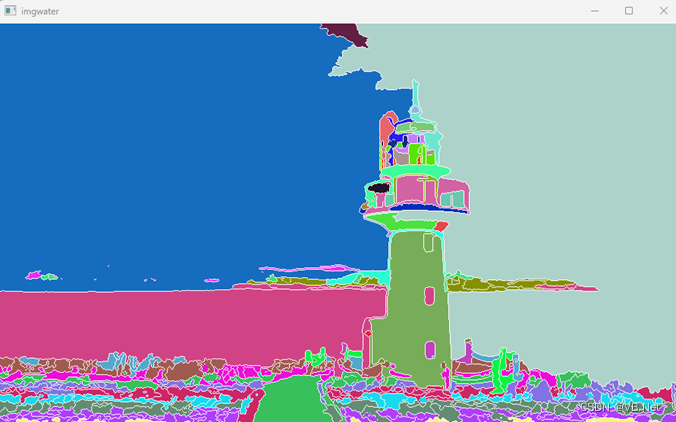版权声明:本文为博主原创文章,转载请在显著位置标明本文出处以及作者网名,未经作者允许不得用于商业目的。
本文的C#版本请访问:图像分割 分水岭法 watershed(C#)-CSDN博客
Watershed算法是一种图像处理算法,它是基于形态学的图像分割方法。在实现中,Watershed算法通常需要先对图像进行预处理,例如去除噪声、边缘检测等操作,以便更好的构建隔板。在填充山谷时,可以使用队列或其他数据结构来实现,以便管理待处理的像素。对于连通的区域,可以使用标记或者颜色来区分。最终得到的分割结果可以用于物体识别、形状分析等应用场景。
CvInvoke.Watershed方法用于执行图像的分水岭分割操作。该方法声明如下:
Public Shared Sub Watershed (
image As IInputArray,
markers As IInputOutputArray
)
参数说明:
- image:输入图像,必须是CV8U三通道彩色图。
- markers:指定的标记图像,这是一个CV32S的单通道图像,并且与输入图像具有相同的尺寸。可以通过FindContours和DrawContours来获得这个图像,使用像数值1、2、3……作为连通分量,来粗略勾勒出图像期望分割的区域,而未确定的区域未标记为0。
该方法没有返回值,而是直接在markers图像上进行分割操作。最终输出的图像,两个区域间使用-1作为分割线。
'分水岭法 watershedPrivate Sub Button4_Click(sender As Object, e As EventArgs) Handles Button4.ClickDim m As New Mat("c:\learnEmgucv\tower.jpg", ImreadModes.Color)'灰度Dim mgray As New MatCvInvoke.CvtColor(m, mgray, ColorConversion.Bgr2Gray)'滤波Dim mgaussian As New MatCvInvoke.GaussianBlur(mgray, mgaussian, New Drawing.Size(5, 5), 2)ImageBox1.Image = mgaussian'边缘检测Dim mcanny As New MatCvInvoke.Canny(mgaussian, mcanny, 60, 120)'ImageBox2.Image = mcanny'获取轮廓Dim contours As New VectorOfVectorOfPointDim hierarchy As New VectorOfRectCvInvoke.FindContours(mcanny, contours, hierarchy, RetrType.Tree, ChainApproxMethod.ChainApproxNone)Dim mmark As New Matmmark = Mat.Zeros(mcanny.Rows, mcanny.Cols, DepthType.Cv32S, 1)'仅为查看轮廓使用Dim mcontours As New Mat(mcanny.Rows, mcanny.Cols, DepthType.Cv8U, 1)For i As Integer = 0 To contours.Size - 1'标记连通分量索引CvInvoke.DrawContours(mmark, contours, i, New MCvScalar(i), 1, LineType.EightConnected, hierarchy)'仅为查看轮廓使用CvInvoke.DrawContours(mcontours, contours, i, New MCvScalar(255), 1, LineType.EightConnected, hierarchy)Next'仅为查看轮廓使用CvInvoke.Imshow("mcontours", mcontours)'mmark是32S,显示不了的'CvInvoke.Imshow("mmark", mmark)'分水岭法CvInvoke.Watershed(m, mmark)'仅演示,watershed后的数据Dim mc As New Matmc = mmark.Clone'转为可以显示的CV8Umc.ConvertTo(mc, DepthType.Cv8U)CvInvoke.Imshow("mc", mc)'使用Matrix和Image便于生成图像(Mat操作像素点比较麻烦)Dim matrwater As New Matrix(Of Int32)(mmark.Rows, mmark.Cols)mmark.CopyTo(matrwater)Dim imgwater As New Image(Of Bgr, Byte)(mmark.Cols, mmark.Rows)'为每个区域填充不同的颜色Dim HSpointcolor As New Hashtable() 'index,bgrDim count As Integer = 0'对每个像素点操作For i As Integer = 0 To matrwater.Rows - 1For j As Integer = 0 To matrwater.Cols - 1'获得连通分量(像素点值)Dim index As Int32 = matrwater(i, j)'如果是区域的分割线If index = -1 Thenimgwater.Data(i, j, 0) = 255imgwater.Data(i, j, 1) = 255imgwater.Data(i, j, 2) = 255ElseDim pointcolor As Bgr'检查是否已经存在索引对应的颜色If HSpointcolor.ContainsKey(index) Thenpointcolor = HSpointcolor(index)Else'获得随机颜色pointcolor = getRadomBgr()'将已经使用的随机颜色加入ListHSpointcolor.Add(index, pointcolor)count += 1End If'像素点填充颜色imgwater.Data(i, j, 0) = pointcolor.Blueimgwater.Data(i, j, 1) = pointcolor.Greenimgwater.Data(i, j, 2) = pointcolor.RedEnd IfNextNext'输出使用分水岭法后的结果CvInvoke.Imshow("imgwater", imgwater)End Sub'获得随机颜色Private Function getRadomBgr() As BgrDim rand As New Random(Now.Millisecond)Dim b As Byte = rand.Next(0, 256)Dim g As Byte = rand.Next(0, 256)Dim r As Byte = rand.Next(0, 256)Return New Bgr(b, r, g)
End Function
输出结果如下图所示:

图8-4 分水岭法使用随机颜色填充
由于.net平台下C#和vb.NET很相似,本文也可以为C#爱好者提供参考。
学习更多vb.net知识,请参看vb.net 教程 目录
)





)
——25. 利用超声波传感器测量距离)
伪色彩应用)


引导启动)







)